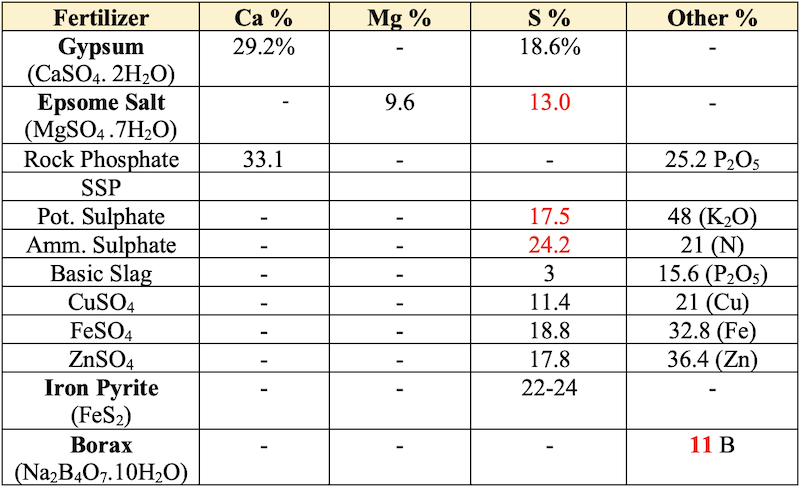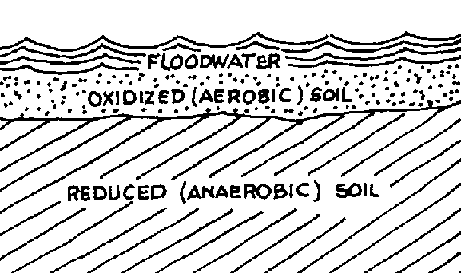🥈 Secondary Fertilizers
Secondary Nutrients, Micronutrients, Methods of application, Suitability, Recommendation, NBS

Gypsum (CaSO4. 2H2O)
- Contains
29.2 % Ca&18.6 % sulphur. - In pulses formed undigestible protein in the deficiency of sulphur.
- Agriculture grade gypsum 70 %.
- In general case 250 kg/ha gypsum used for sulphur & calcium especially in onion, mustard, groundnut and pulse crops.
- In
alkali soilfor reclamation purpose Gypsum is used @ 800 k/ha.
Micronutrients
- Some of the metallic micronutrient salts when applied to the soil, are transformed into non-available forms due to their reactivity. Organic compounds like EDTA (Ethylenediamine Tetra Acetic Acid), DTPA (Diethylene triamine penta acetic acid), CDTA (Cyclohexane diamine tetracetic acid) have the ability to chelate or loosely hold metallic ions in their cyclic structure and these metal-organic complexes are called metal chelates.
- Metal chelates are soluble in water but they do not ionize in soil solutions. Metal ions therefore, don’t react with soil constituents; Chelate forms of nutrient are more available. Fe, Cu, Zn and Mn are available in chelate form.
- 50% of Indian soil is deficient in
Zincand 25% of Indian soil insulphur. Ammonium Molybdate: used as foliar spray. In pulses, Mo is more important nutrient because it is constitute of leghaemoglobin hence can be used @ 3g/kg seed of pulses. (Mo = 54%).Zinc Sulphate: contains 36 % zinc is the most commonly used zinc fertilizer. It applies as both to soil (at 25 kg/ha) and plant (0.5 % as spray). Zinc oxide (78 %) used as seed treatment.Ferrous Sulphate: is the most commonly used fertilizer which is sprayed @ 0.5 % on the standing crops to control iron chlorosis. It contains 33 % Fe.Manganese Sulphate: is the most popular manganese fertilizer which contains 26 % manganese.Copper Sulphate: is commonly used for both spraying on plants and applying as soil contains 21 % copper.Borax: is the most commonly used for boron fertilizer which is white compound containing11 % boron. It is highly soluble in water, hence should be used as boron frits.
Methods of fertilizer application

a. Basal dose
- Application of fertilizer/pesticides at the time of sowing.
- Phosphorus & Potassic fertilizers are applied at basal dose due to their slow release nature.
b. Deep placement of fertilizer
- In paddy only
ammonium form(NH4+) incorporated inreduced zoneto prevent leaching and volatilization losses. UPPSC 2021
c. Starter dose
- In legume and vegetable seedling at transplanting applied NPK at 1:2:1 ratio.
d. Split doses of N fertilizer
- To increase N efficiency, applied 2 split doses in most of cereals having crop duration 4-5 months.
- Applied 3 split doses for crop having duration more than five months.
Suitability of fertilizers
- Indian soils are universal deficient in
NitrogenandZinc. - The crops which absorb the Ammonical form directly -
Paddy&Potato - Ammonical fertilizer should be applied in
Reduced zone. - Nitrate fertilizer should be applied in
Oxidised zone. - Major source of nitrogen absorption Nitrate (NO3-) form
- In acidic soils,
Rock phosphateandSSPis used instead DAP. - In saline & alkali soils ammonical fertilizers are not recommended because
alkalization of ammoniatakes place. - Potassic fertilizers is suitable for acidic and heavy soils but not for alkaline soils.
- In anaerobic soils, sulphates are reduced to hydrogen sulphide by the action of De-sulfo vibro bacteria.
- Elemental sulphur when applied to the soil is converted to sulphate by Thiobacillus spp.
S →(Thiobacillus)→ SO42-
- De. Datta and Gomez (1975) observed: The N-efficiency was highest in the first rice crop and declined progressively with successive rice crops.
- K-efficiency however, increased sharply over the years, especially during the dry season.
- In seed crops, last application of N during seed development phase improves the quality and germinability of seeds. The application of last doze of N should be foliar.
- In determinate grain crops like rice, wheat, maize; N-supply at the begining of the reproductive phase (e g. panicle initiation) as the last doze increases the number and weight of grains.
- In indeterminate plants e.g. rape, sesame, cotton, N-application at the flowering stage and another at the late flowering stage increases the yield & quality.
- If there is luxuriant consumption of N, a growth modifier say cycocel may be applied to enhance reproductive growth and yield
- Plants require a greater amount of ‘P’ at their early stages (for root growth) but plant absorbs K upto harvesting and K- fertilizer becomes available slowly.
Rabbingmeans heat treatment applied to soil by burning refuse placed over it.
General Recommendation Fertilizer Doses (N:P:K)

- The unacceptably large urea subsidy has ensured that against the ideal N:P:K ratio of
4 : 2 : 1, the average in India is6.1 : 2.5 : 1, and it is as much as 25.8 : 5.8 : 1 in states like Punjab.
Nutrient based subsidy (NBS) Scheme
- It is being implemented form
April 2010by the department of Fertilizers, Ministry of Chemicals & Fertilizers. - Under NBS, Government provides fertilizers, Urea and 21 grades of P & K fertilizers to farmers at subsidized prices through fertilizer manufacturers/importers.
- Considering that fertilizer subsidy is the second-biggest subsidy after food subsidy, the inaction on the part of the government is not only worrying for the fiscal health of the economy but also detrimental to the soil health of the country.
- An undesirable outcome has been the change in fertilizer mixture as against the recommended Nitrogen (N): Phosphorous (P): Potassium (K) ratio of 4 : 2 : 1, the NPK ratio in 2013-14 was 8.2 : 3.2 : 1.


Gypsum (CaSO4. 2H2O)
- Contains
29.2 % Ca&18.6 % sulphur. - In pulses formed undigestible protein in the deficiency of sulphur.
- Agriculture grade gypsum 70 %.
- In general case 250 kg/ha gypsum used for sulphur & calcium especially in onion, mustard, groundnut and pulse crops.
- In
alkali soilfor reclamation purpose Gypsum is used @ 800 k/ha.
Micronutrients
- Some of the metallic micronutrient salts when applied to the soil, are transformed into non-available forms due to their reactivity. Organic compounds like EDTA (Ethylenediamine Tetra Acetic Acid), DTPA (Diethylene triamine penta acetic acid), CDTA (Cyclohexane diamine tetracetic acid) have the ability to chelate or loosely hold metallic ions in their cyclic structure and these metal-organic complexes are called metal chelates. …
Become Successful With AgriDots
Learn the essential skills for getting a seat in the Exam with
🦄 You are a pro member!
Only use this page if purchasing a gift or enterprise account
Plan
Rs
- Unlimited access to PRO courses
- Quizzes with hand-picked meme prizes
- Invite to private Discord chat
- Free Sticker emailed
Lifetime
Rs
1,499
once
- All PRO-tier benefits
- Single payment, lifetime access
- 4,200 bonus xp points
- Next Level
T-shirt shipped worldwide

Yo! You just found a 20% discount using 👉 EASTEREGG

High-quality fitted cotton shirt produced by Next Level Apparel